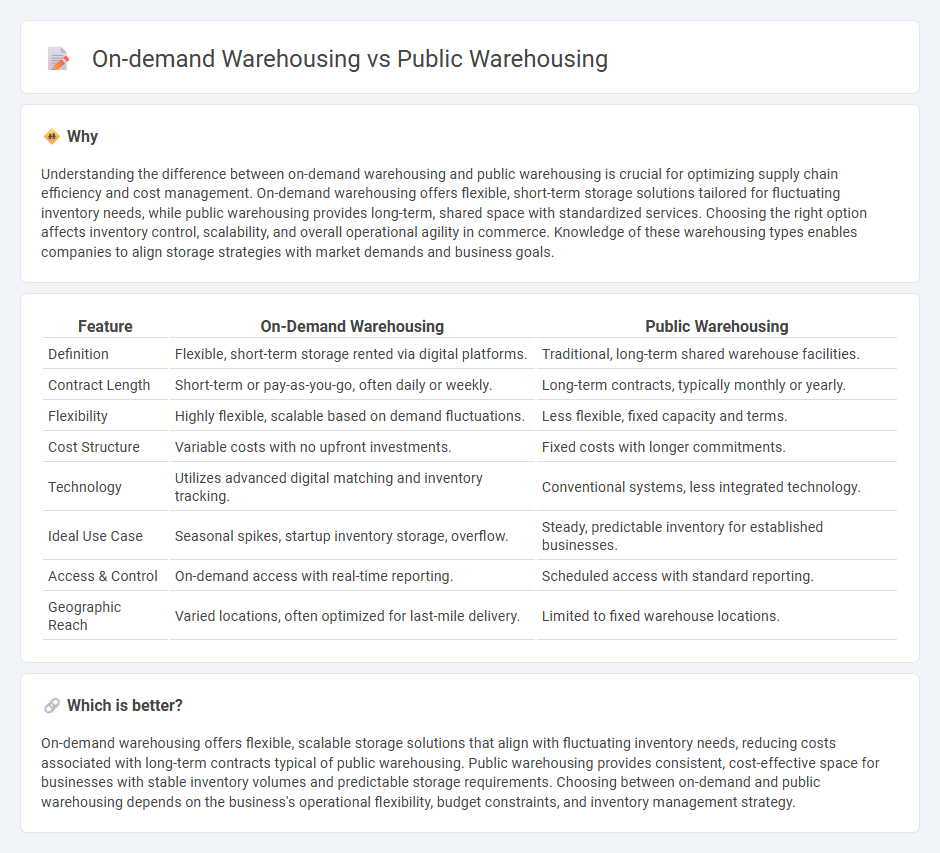
On-demand warehousing offers flexible, scalable storage solutions by connecting businesses with excess warehouse space through digital platforms, enabling cost-effective and real-time inventory management. Public warehousing provides long-term, shared storage facilities managed by third-party providers, suitable for companies seeking reliable, fixed-location storage without ownership burdens. Explore the advantages of on-demand and public warehousing to determine the optimal approach for your supply chain needs.
Why it is important
Understanding the difference between on-demand warehousing and public warehousing is crucial for optimizing supply chain efficiency and cost management. On-demand warehousing offers flexible, short-term storage solutions tailored for fluctuating inventory needs, while public warehousing provides long-term, shared space with standardized services. Choosing the right option affects inventory control, scalability, and overall operational agility in commerce. Knowledge of these warehousing types enables companies to align storage strategies with market demands and business goals.
Comparison Table
| Feature | On-Demand Warehousing | Public Warehousing |
|---|---|---|
| Definition | Flexible, short-term storage rented via digital platforms. | Traditional, long-term shared warehouse facilities. |
| Contract Length | Short-term or pay-as-you-go, often daily or weekly. | Long-term contracts, typically monthly or yearly. |
| Flexibility | Highly flexible, scalable based on demand fluctuations. | Less flexible, fixed capacity and terms. |
| Cost Structure | Variable costs with no upfront investments. | Fixed costs with longer commitments. |
| Technology | Utilizes advanced digital matching and inventory tracking. | Conventional systems, less integrated technology. |
| Ideal Use Case | Seasonal spikes, startup inventory storage, overflow. | Steady, predictable inventory for established businesses. |
| Access & Control | On-demand access with real-time reporting. | Scheduled access with standard reporting. |
| Geographic Reach | Varied locations, often optimized for last-mile delivery. | Limited to fixed warehouse locations. |
Which is better?
On-demand warehousing offers flexible, scalable storage solutions that align with fluctuating inventory needs, reducing costs associated with long-term contracts typical of public warehousing. Public warehousing provides consistent, cost-effective space for businesses with stable inventory volumes and predictable storage requirements. Choosing between on-demand and public warehousing depends on the business's operational flexibility, budget constraints, and inventory management strategy.
Connection
On-demand warehousing leverages the flexible storage capacity of public warehousing facilities, enabling businesses to scale inventory space dynamically without long-term leases. Public warehousing provides the physical infrastructure and shared resources that on-demand platforms utilize for real-time storage allocation and distribution. This synergy enhances supply chain efficiency by optimizing inventory management and reducing warehousing costs.
Key Terms
Storage flexibility
Public warehousing offers scalable storage solutions with long-term contracts, ideal for businesses needing consistent inventory space. On-demand warehousing provides unparalleled storage flexibility, enabling companies to quickly adjust storage capacity based on real-time needs and seasonal fluctuations. Explore how choosing the right warehousing model can optimize your supply chain efficiency.
Cost structure
Public warehousing typically involves fixed rental fees and long-term contracts, offering predictable costs but less flexibility in scaling storage needs. On-demand warehousing charges variable fees based on actual usage and time, reducing overhead and allowing businesses to pay only for the space they use. Explore detailed comparisons to determine which cost structure aligns best with your operational goals.
Inventory management
Public warehousing offers businesses standardized storage solutions with consistent inventory tracking systems, ideal for long-term stock management and predictable demand. On-demand warehousing provides flexible, scalable inventory storage options, allowing companies to adapt quickly to fluctuating market needs and seasonal spikes without committing to fixed contracts. Explore more to understand which inventory management model best suits your operational goals and cost-efficiency priorities.
Source and External Links
What is Public Warehousing? - Axis Warehouse - Public warehousing is a cost-efficient storage solution offered by third-party providers where multiple businesses store goods under one roof with flexible terms and value-added logistics services managed by experts.
Public Warehouse: Definition, Benefits, and Features - Public warehouses provide businesses with flexible, shared storage space without high upfront costs, offering benefits like improved shipping efficiency but less control over inventory management.
What Is Public Warehousing? Benefits, Types & How It Works - Public warehouses are third-party multi-client facilities that offer scalable, pay-per-use storage ideal for fluctuating inventory needs, differing from private warehouses by lower costs and less operational control.
 dowidth.com
dowidth.com